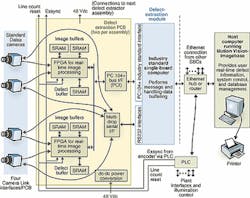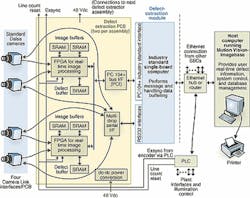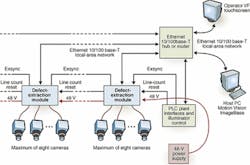Web-inspection system checks polyimide film
Andrew Wilson, Editor, [email protected]
The DuPont Corp. High Performance Materials Division (Circleville, OH; www.dupont.com) manufactures Kapton, a polyimide film that maintains its physical, electrical, and mechanical properties over a wide temperature range. Used in a variety of electrical and electronic insulation applications, including wire and cable tapes, formed coil insulation, substrates for flexible printed circuits, and transformer and capacitor insulation, Kapton does not melt or burn during use at both high and low temperatures.
Before shipping, rolls of Kapton film are inspected using a high-speed machine-vision system that detects, extracts, and classifies defects. Ten years ago, DuPont contracted Dalsa (Waterloo, Ontario, Canada) to build an automated system capable of inspecting the polyimide film at high speed. The result was MotionVision, a multicamera web-inspection system designed to operate with the company's CT-E1 and CT-E2 camera technology.
In its next-generation architecture Motion Vision web-inspection system, Dalsa will move away from proprietary technology. Instead, the company will develop PC-104+ defect-extraction boards that will interface to standard SBCs over the PC-104+ interface (top). By using a number of defect-extraction modules, which consist of two defect-extraction boards, up to eight cameras per module can be supported (bottom). Daisy-chaining these modules will allow systems developers to build multiple linescan-based web-inspection systems.
"In the design of the initial system," says Graham Luckhurst, applied research manager of the Dalsa Vision Systems Group, "we realized that a large amount of data being collected was redundant." Based around proprietary digital-signal-processing functions in each camera implemented using complex programmable logic devices, the system supported up to 20 smart cameras connected to a data-collection hub. Under control of a custom-built microcontroller board, each digital-signal processor would threshold the incoming data stream and isolate the defects.
"With the data reduction and image analysis performed locally," says Luckhurst, "relevant image data are then transferred, via the data-collection hub, to a custom fiberoptic converter board." Defect data are then transmitted and received at a remote PC workstation by a C80-based Genesis frame-grabber board from Matrox (Dorval, Canada). Using Matrox's Genesis Native Library under Windows NT, the PC host running Motion Vision software manages how defects have been detected, classified, and stored using a Windows user interface.
In its next-generation Motion Vision architecture, however, Dalsa's vision systems are moving away from proprietary technology. In the new process, Dalsa will abandon the C80-based Genesis in favor of an architecture based on an industry-standard PC-104+ single-board computer (SBC; see figure).
"As the speeds of standard PC and network technologies have increased," says Luckhurst, "systems developers can leverage a number of off-the-shelf products such as SBCs, Ethernet hubs and routers, host computers, and programmable logic controllers, speeding product time to market and lowering the cost of product design."
In the next-generation design, a number of linescan and advanced linescan cameras, including Spyder, Pirahna2, and Eclipse cameras, will interface to a series of PC-104+ defect-extraction boards. Installed on these boards, FPGAs will provide threshold and defect-identification functions. Once defects are detected, they can be stored in a defect buffer and accessed over the PC-104+ bus by the SBC for transmission to the host via Ethernet.
According to Luckhurst, each defect-extraction board will support up to four linescan cameras, with two such boards making up a defect-extraction "module" that will support up to eight cameras. When arrayed in a series, these modules will support a number of cameras in multiples of eight cameras per module. And, because each module also supports Ethernet protocols, they can be readily interfaced to Ethernet hubs or routers and host PCs. Luckhurst adds, "We removed the DSP function from the camera and located it in a local module, which allows a single image-processing module to supports all of Dalsa's latest standard camera products."
Like its predecessor, the next-generation Motion Vision System will be PC-based and run an enhanced version of Motion Vision software that is tailored to run on the PC rather than with a C80-based frame grabber.


